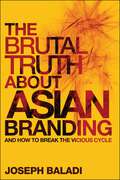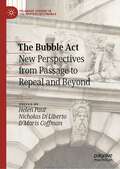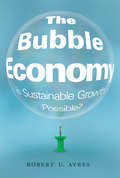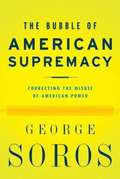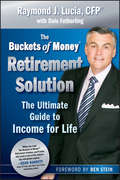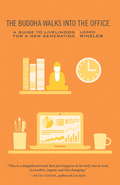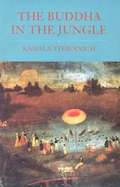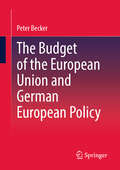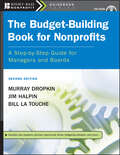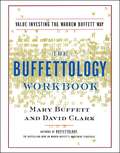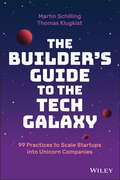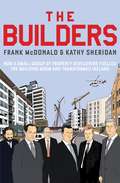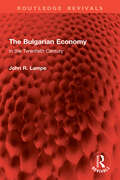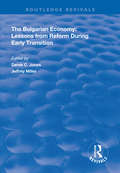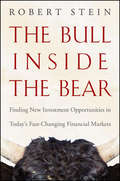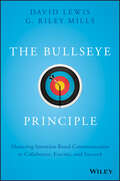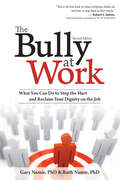- Table View
- List View
The Brusov–Filatova–Orekhova Theory of Capital Structure: Applications in Corporate Finance, Investments, Taxation and Ratings
by Peter Brusov Tatiana Filatova Natali OrekhovaThe book introduces and discusses the modern theory of the cost of capital and capital structure - the BFO theory (Brusov-Filatova-Orekhova theory), which is valid for companies of arbitrary age and which replaced the theory of Nobel laureates Modigliani and Miller. The theory takes into account the conditions faced by companies operating in the real economy, such as revenue fluctuations; the arbitrary frequency of tax on profit payments (monthly, quarterly, semi-annual or annual payments), both for advance income tax payments and for payments at the end of the respective period; and the arbitrary frequency of interest on loans payments. The impact of these conditions on the company value, on the cost of raising capital, on the company's dividend policy and managerial decisions are discussed. The book subsequently develops new applications of the BFO theory in several areas such as corporate finance, corporate governance, investments, taxation, business valuations and ratings.
The Brutal Truth About Asian Branding
by Joseph BaladiThis is one of the most thoughtful books on branding I've come across. Most such books are either quickly-crafted "how-to" books or academic tomes over-burdened with references. This book is thoughtful because it raises questions which deal with the "why" rather than just "how" of branding. The reference to brutal truth as the truth which will set us free-to examine ourselves without self-illusions-is liberating. The notion that Asia has many good, but no great brands, is also not a put-down but a clarion call for Asian CEOs to rise to the challenge and create lasting, meaningful, committed brands. Ho Kwon Ping Chairman/CEO, Banyan Tree and Board of Trustees, SMU 2010 recipient of the "Lifetime Achievement Award" by the American Creativity Association A cold shower to wake people up. Joe Baladi's Brand Blueprint is a great tool for anyone involved in Sovereign Relationship Marketing or brand building anywhere. Timothy Love Vice Chairman Chief Executive Officer, Omnicom APIMA There are many books about branding but few address Asian companies directly. Joe Baladi has been one of the loudest voices to advocate strong branding practices to Asian companies determined to outperform their competitors. The Brutal Truth About Asian Branding is a timely book that all Asian CEOs with global aspirations should read. Richard Eu Group CEO, Eu Yan Sang International The Brutal Truth About Asian Branding is the first book that connects branding frameworks to the realities of operating in Asia. It offers a very straightforward perspective on the challenges Asian CEOs face as they build their businesses and their brands, and perhaps the most compelling part of the book is the passionate plea for how Asian CEOs should be thinking different about branding. In true Baladi style, it is straight from the heart. Maarten Kelder Managing Partner (Asia), Monitor Group A very interesting and valuable perspective on Asian branding. . . one that decision makers in the region should read and embrace. Well done Joe! Ron Sim Founder & CEO, OSIM International Brands mean Business, anywhere in the world! The focus on Asia, at this time, is natural since the developing nations of the region did so much to help the world recover from the global 2008 economic crisis. Baladi's text is timely; it is thoughtful and thought-provoking; putting people and brands center stage with practical insights borne of his breadth of personal experience at the frontline. Chris D. Beaumont Professor, Tokyo University, Global Centre of Excellence Director, North Asia, Results International The brutal truth is that Joe Baladi is right. Asian CEOs must learn the brand skills used so successfully in the rest of the world. It will take a big change in mentality, but the rewards will be vast. This book is a great start to that revolution. Michael Newman Author, 22 Irrefutable Laws of Advertising
The Bubble Act: New Perspectives from Passage to Repeal and Beyond (Palgrave Studies in the History of Finance)
by D’Maris Coffman Helen Paul Nicholas Di LibertoThis book reassesses the actual effects of the Bubble Act, still popularly associated with the bursting of the South Sea Bubble. The book builds on the foundational work of Ron Harris to discuss the act’s effect on corporate governance, literary culture, colonial law, and the Industrial Revolution. The Bubble Act was deemed an empty letter within England itself as it was rarely used in legal proceedings. Several chapters consider whether this was the case outside England, from Scotland to the Americas, India, and Africa. Others assess the impact of the act, both on literary culture and in the history of economic thought. The act has been conceptualized as a brake on economic development or of little consequence. This edited collection offers a timely reassessment of the Bubble Act and its legacy.
The Bubble Economy: Is Sustainable Growth Possible?
by Robert U. AyresWhy the global economy has become increasingly unstable, and how financial "de-carbonization" could break the pattern of bubble-driven wealth destruction.
The Bubble Economy: Is Sustainable Growth Possible? (The\mit Press Ser.)
by Robert U. AyresWhy the global economy has become increasingly unstable, and how financial “de-carbonization” could break the pattern of bubble-driven wealth destruction.The global economy has become increasingly, perhaps chronically, unstable. Since 2008, we have heard about the housing bubble, subprime mortgages, banks “too big to fail,” financial regulation (or the lack of it), and the European debt crisis. Wall Street has discovered that it is more profitable to make money from other people's money than by investing in the real economy, which has limited access to capital—resulting in slow growth and rising inequality. What we haven't heard much about is the role of natural resources—energy in particular—as drivers of economic growth, or the connection of “global warming” to the economic crisis. In The Bubble Economy, Robert Ayres—an economist and physicist—connects economic instability to the economics of energy.Ayres describes, among other things, the roots of our bubble economy (including the divergent influences of Senator Carter Glass—of the Glass-Steagall Law—and Ayn Rand); the role of energy in the economy, from the “oil shocks” of 1971 and 1981 through the Iraq wars; the early history of bubbles and busts; the end of Glass-Steagall; climate change; and the failures of austerity.Finally, Ayres offers a new approach to trigger economic growth. The rising price of fossil fuels (notwithstanding “fracking”) suggests that renewable energy will become increasingly profitable. Ayres argues that government should redirect private savings and global finance away from home ownership and toward “de-carbonization”—investment in renewables and efficiency. Large-scale investment in sustainability will achieve a trifecta: lowering greenhouse gas emissions, stimulating innovation-based economic growth and employment, and offering long-term investment opportunities that do not depend on risky gambling strategies with derivatives.
The Bubble Theory: Towards a Framework of Enlightened Needs and Fair Development
by Min DingThe term sustainable development (SD) has now become a ubiquitous idea, philosophy, and guiding principle in our society. Governments, business, NGOs and individuals have embraced the mindset, and even the education institutions talk about graduating young people with sustainability in their DNA. Despite its noble origin, however, sustainable development is a concept that embodies compromise. This compromise has led to a term that is devoid of scientific foundation and actionable guidelines. In this volume, Min Ding offers an alternative to SD, introducing a framework, which he calls the Bubble Theory, built on three layers: the symbiotic duo (subconscious desires at the self and species levels); enlightened needs (manifested desires of the self and species beyond basic survival and procreation), and human development principles (with fair development as the ideal principle for the present). These fundamental concepts of enlightened needs (EN) and fair development (FD) have profound implications for both the theory and application of new practices in business and policymaking.
The Bubble of American Supremacy
by George SorosIn an effort to closely examine the American foreign policy in the wake of the September 11, 2001 attack, George Sorows describes the climb to power of the American Supremacist group in the Bush cabinet. These group of radical extremists have redefined the American Foreign policy to base it on power in stead of demoratic principles. Sorows argues to redefine the policy by multilateral actions and better economic policies to avert a potential disaster. Sorows provides historical analysis, describes the current state of affairs and presents solutions to the upcoming challenge.
The Buckets Of Money Retirement Solution
by Ben Stein Lucia Raymond J.Investors, shell-shocked by the "Great Recession" of 2008-2009, are looking for answers, for something fresher than the old 'buy-and-hold' mantra. They hunger for stability, yet yearn for growth to rejuvenate their battered portfolios. Ray Lucia's The Buckets of Money Retirement Solution: The Ultimate Guide to Income for Life provides just that-a reassuring and scientifically proven strategy that gives investors both growth and income. Lucia, a Certified Financial Planner who's helped thousands of people invest more than $2 billion, explains how to spend down 'safe' buckets (containing, for example, Treasuries, CDs, bonds), while leaving a riskier bucket (real estate, stocks and alternative investments) to grow long-term. This strategy shields investors from the short-term ups and downs of the market. And it gives them the courage and discipline to stay invested no matter what the future holds. Written in a breezy, accessible style and loaded with tons of examples and clear, specific calculations, the book explains how to set your financial goals, divvy up your money accordingly, and then invest intelligently. With this book as your guide, readers will learn how to achieve both income and growth while at the same time reducing risk. "All in all," Lucia writes, "this plan is akin to a sports car that seats six, approximating the best of both worlds. In this case by being a conservative strategy that's also growth-oriented. " Almost every kind of investment-stocks, bonds, commodities, real estate-plunged in the past year or two, turning off millions of investors who'd been planning for and counting on a reasonably comfortable retirement. These retirees or near-retirees need solutions . . . something fresher than the old 'buy-and-hold' mantra. Yet here's what they hear from the financial-services industry: Set up an asset-allocation model, then take a systematic withdrawal to support your retirement . . . remembering, of course, to rebalance the accounts to remain in sync with the model. Wrong! That maximizes the advisors' fees but doesn't protect the investors' assets during the tough times.
The Buddha Walks into the Office
by Lodro RinzlerFrom the author of the best-selling Buddha Walks into a Bar . . . , wisdom for "Generation Next" on how to make your work meaningful, satisfying, and of benefit to others. Does it ever seem that a lot of the people you work with are, well, jerks? This book is about how not to let work turn you into one of them. Apply the simple Buddhist teachings and practices Lodro Rinzler provides here to whatever you do for a living, and you'll not only avoid jerk-hood, but you'll be setting out on the path toward making your livelihood an expression of your inherent wisdom, honesty, and compassion. You'll discover practical ways to bring mindfulness into administrative support, cabinet-making, financial management, nursing, truck-driving, or latté-brewing. In the process, you'll discover genuine empathy for the folks you once found so difficult. You'll also learn leadership skills that apply compassion to management in a way that increases happiness along with efficiency. This is career advice of the profoundest kind, geared toward today's twenty- and thirty-something workers and job-seekers whose employment outlook is radically different from that of a generation ago. As Lodro shows, even if the path of work shifts beneath your feet, it's possible to make your livelihood a source of satisfaction and of deep meaning.
The Buddha in the Jungle
by Kamala TiyavanichA Thai Buddhist and US-trained historian, Tiyavanich weaves together stories about Siam in the 19th and early 20th centuries that illuminate the life of the Buddhist culture. They tell of village monks encountering giant snakes, a Christian missionary gored by an elephant, bandits and boatmen, a dog-bodhisattva, midwives, guardian spirits, and other topics. Distributed in the US by the University of Washington Press. Annotation ©2004 Book News, Inc. , Portland, OR (booknews. com)
The Budget of the European Union and German European Policy
by Peter BeckerThis book presents in detail the negotiations on the budget of the European Union, which take place every seven years, and discusses the central elements of this European budgetary system. The author explains the various interests and the resulting distributional conflicts, traces the genesis of this highly complex process, discusses the system of inflows and reflows, and sheds particular light on German European policy.
The Budget-Building Book for Nonprofits
by Murray Dropkin Jim Halpin Bill La ToucheThis best-selling nuts-and-bolts workbook, now in its second edition, has become the gold standard for nonprofit managers and boards who must work through the budget cycle. The book offers practical tools and guidance for completing each step of the budgeting process. Designed to be comprehensive and easy to use, The Budget-Building Book for Nonprofits provides everything budgeters and nonfinancial managers need to prepare, approve, and implement their own budgets.Includes new chapters on Zero-Based and Capital Budgeting as well as a CD with spreadsheets, worksheets and a new budget-building software, the CMS Nonprofit Budget Builder, designed to help you implement the concepts in the book. The software includes an expandable standard chart of accounts (COA) and will aid in building, organizing, tracking and planning budgets.
The Builder's Guide to the Tech Galaxy: 99 Practices to Scale Startups into Unicorn Companies
by Martin Schilling Thomas KlugkistLearn to scale your startup with a roadmap to the all-important part of the business lifecycle between launch and IPO In The Builder&’s Guide to the Tech Galaxy: 99 Practices to Scale Startups into Unicorn Companies, a team of accomplished investors, entrepreneurs, and marketers deliver a practical collection of concrete strategies for scaling a small startup into a lean and formidable tech competitor. By focusing on the four key building blocks of a successful company – alignment, team, functional excellence, and capital—this book distills the wisdom found in countless books, podcasts, and the authors&’ own extensive experience into a compact and accessible blueprint for success and growth. In the book, you&’ll find: Organizational charts, sample objectives and key results (OKRs), as well as guidance for divisions including technology and product management, marketing, sales, people, and service operations Tools and benchmarks for strategically aligning your company&’s divisions with one another, and with your organization&’s &“North Star&” Templates and tips to attract and retain a triple-A team with the right scale-up mindset Checklists to help you attract growth capital and negotiate term sheetsPerfect for companies with two, ten, or one hundred employees, The Builder&’s Guide to the Tech Galaxy belongs on the bookshelves of founders, managers, entrepreneurs, and other business leaders exploring innovative and proven ways to scale their enterprise to new heights.
The Builders: How a Small Group of Property Developers Fuelled the Building Boom and Transformed Ireland
by Frank McDonald Kathy SheridanIn the past fifteen years, Ireland has gone from being one of the poorest countries in the EU to one of the richest in the world. Of all the factors in this extraordinary transformation, none has been more prominent than the astonishing boom in construction. In The Builders, Frank McDonald and Kathy Sheridan tell the stories of these men and of the changes - physical and psychological - they have brought about. The story of Ireland's property developers has been the great untold story of the boom - until now.'Essential reading' Sunday Business Post
The Building Blocks of ROI
by John Case Karen Berman Joe KnightThis chapter discusses foundational principles, including the time value of money, for making decisions relating to capital investment in corporate America.
The Building Blocks of ROI: How to Calculate and Understand Return on Investment
by Karen Berman Joe KnightThis chapter discusses foundational principles, including the time value of money, for making decisions relating to capital investment in corporate America. To be a successful entrepreneur, you must understand the basics of spending cash in the hope of realizing a return - like buying a new machine or software application. This chapter is excerpted from "Financial Intelligence for Entrepreneurs: What You Really Need to Know About the Numbers."
The Bukharans: A Dynastic, Diplomatic and Commercial History 1550-1702
by Audrey BurtonThis is an in-depth study of the people of Bukhara and their relations with settled peoples and nomads, from Muscovy to China, and Iran to India. By using lesserknown, or hitherto untapped sources, it corrects long-held misapprehensions fostered by historians of hostile states and champions of the Timurid dynasty. Far from being afraid of their powerful Safawid and Mughal counterparts, the Uzbeg rulers of Bukhara caused them much apprehension and even influenced their foreign policies. 'Abbas I concluded a humiliating peace with Turkey because he wanted to recover Khurasan from 'Abdallah II, Akbar could not risk leaving Punjab during 'Abdallah's reign, Safawid and Mughal attempts at conquering the khanate failed dismally. The book deals fully with dynastic, internal and external problems, trade routes, coinage policies and the khans' attempts to encourage trade.
The Bulgarian Economy: In the Twentieth Century (Routledge Revivals)
by John R. LampeFirst published in 1986, The Bulgarian Economy (now with a new preface by the author) traces the rapid growth of the Bulgarian economy throughout the twentieth century. It also notes the obstacles Bulgaria has faced in bringing about industrial development in a small relatively poor country where, in the early twentieth century, agriculture predominated. It explores the difficulties which have arisen because of the unusual domination of a relatively isolated capital city, Sofia, over the rest of the country. It examines the effects of Bulgaria’s being on the losing side in three wars. An abrupt change in economic strategy and management came with the Communist accession to power in 1944 and with the simultaneous reorientation from close ties with Germany to close ties with the Soviet Union. The book shows, however, that significant state control had appeared well before this transition and that there is much in common between the pre- and post-war periods. It goes on to emphasise economic growth and structural change in the post-war period and the unusually large role of foreign trade. The reforms which have taken place since 1960 are accorded a separate, final chapter.
The Bulgarian Economy: Lessons from Reform During Early Transition (Routledge Revivals)
by Jeffrey Miller Derek C. JonesFirst published in 1997, this volume examines how Bulgaria has been an early starter, but a slow and often erratic mover in the path of stabilization and systemic transition. This book provides a most useful account of the development to date, and of the costs associated with Bulgarian strategy (or lack of), empirical analysis and theoretical reflections, especially in comparison with other transition economies. It will be of great interest to any scholar, official or businessman involved not only with Bulgaria, but more generally with post-communist countries.
The Bull Inside the Bear
by Robert SteinThe meltdown in the credit markets, the decline in housing prices, and the turmoil in the stock market has rocked the world of the everyday investor. The idea that home ownership and the stock market are the best long-term investments suddenly has been thrown into question. Bearish investment experts are touting historical research that suggests both real estate values and the stock market could stagnate for years to come, thus imperiling the retirement planning of millions of Americans. In The Bull Inside the Bear, investment manager and former Federal Reserve economist Rob Stein argues that the economy is entering uncharted water and investors need to actively manager their portfolios to take advantage of new opportunities and avoid risky sectors. No longer can investors simply rely on a "buy and hold" strategy. The key will be to stay nimble and be ready to increase stock holdings if the economy recovers strongly and be ready to substantially reduce stock holdings if the current problems continue to weigh down economic performance. Moreover, investors must be open to weighting their portfolios in favor of hot sectors depending on economic and financial market performance. Stein argues that it will take several years for the credit markets to stabilize following the crash of the Greenspan-driven credit expansion, which will make investing far more volatile and unpredictable than previously. But by adroitly moving in and out of exchange-traded funds, individual investors will be able to prosper in this new and challenging investment environment.
The Bullet Journal Method: Track the Past, Order the Present, Design the Future
by Ryder CarrollThe long-awaited first book by the founder of the enormously popular Bullet Journal® organizational system.For years Ryder Carroll tried countless organizing systems, online and off, but none of them fit the way his mind worked. Out of sheer necessity, he developed a method called the Bullet Journal that helped him become consistently focused and effective. When he started sharing his system with friends who faced similar challenges, it went viral. Just a few years later, to his astonishment, Bullet Journaling is a global movement. The Bullet Journal Method is about much more than organizing your notes and to-do lists. It's about what Carroll calls "intentional living": weeding out distractions and focusing your time and energy in pursuit of what's truly meaningful, in both your work and your personal life. It's about spending more time with what you care about, by working on fewer things. His new book shows you how to... * Track the past: Using nothing more than a pen and paper, create a clear and comprehensive record of your thoughts. * Order the present: Find daily calm by tackling your to-do list in a more mindful, systematic, and productive way. * Design the future: Transform your vague curiosities into meaningful goals, and then break those goals into manageable action steps that lead to big change. Carroll wrote this book for frustrated list-makers, overwhelmed multitaskers, and creatives who need some structure. Whether you've used a Bullet Journal for years or have never seen one before, The Bullet Journal Method will help you go from passenger to pilot of your own life.
The Bullies of Wall Street
by Sheila BairCan knowing how a financial crisis happened keep it from happening again? Sheila Bair, the former chairman of the FDIC, explains how the Great Recession impacted families on a personal level using language that everyone can understand.In 2008, America went through a terrible financial crisis, and we are still suffering the consequences. Families lost their homes, had to give up their pets, and struggled to pay for food and medicine. Businesses didn't have money to buy equipment or hire and pay workers. Millions of people lost their jobs and their life savings. More than 100,000 businesses went bankrupt. As the former head of the Federal Deposit Insurance Corporation, Sheila Bair worked to protect families during the crisis and keep their bank deposits safe. In The Bullies of Wall Street, she describes the many ways in which a broken system led families into financial trouble, and also explains the decisions being made at the time by the most powerful people in the country--from CEOs of multinational banks, to heads of government regulatory committees--that led to the recession.
The Bullseye Principle: Mastering Intention-Based Communication to Collaborate, Execute, and Succeed
by David Lewis G. Riley MillsCritical communication lessons for sustained corporate success The Bullseye Principle is the definitive how-to guide for communicating, collaborating, and executing as a leader in the corporate arena. With these “soft skills” trending above technical knowledge in executive wish lists, this book provides invaluable guidance for new and experienced leaders alike; from the planning stages to the outcome and beyond, the discussion features critical insight and actionable tips based on award-winning methods. Polish your presence, utilize intention, influence emotion, engage workers, build relationships, make connections, and leverage the power of storytelling—it all comes down to technique. This book shows you everything you need to know to start communicating more effectively, starting today. The success of any communication rests more on how the information is conveyed than what that information actually is; at every level, in every sphere, effective leaders strive to master key skills that inspire, empower, motivate, and more. This book gives you a solid blueprint for effective communication in nearly any situation, merging the practical and theoretical to help you: Master the most challenging business interactions Become more influential as a leader and communicator Adopt a 3-step methodology to collaborate more effectively Build your personal brand and executive presence toward sustained success Most people believe that their communications skills are satisfactory for their jobs—most managers would disagree. That gap in perception presents a problem that ripples beyond your chances of promotion—where your communication fails, it has the capacity to affect the organization as a whole. The Bullseye Principle helps you build a robust repertoire of communication skills that put you ahead of the pack.
The Bully at Work: What You Can Do to Stop the Hurt and Reclaim Your Dignity on the Job
by Gary Namie Ruth NamieA landmark book that blazed light on one of the business world's dirtiest secrets, The Bully at Work exposed the destructive, silent epidemic of workplace bullying that devastates the lives, careers, and families of millions. In this completely updated new edition based on an updated survey of workplace issues, the authors explore new grounds of bullying in the 21st century workplace. Gary and Ruth Namie, pioneers of the Campaign Against Workplace Bullying, teach the reader personal strategies to identify allies, build their confidence, and stand up to the tormentor - or decide when to walk away with their sanity and dignity intact. The Namies' expertise on workplace bullying has been featured in such media outlets as The Early Show, CBS Radio, The Howard Stern Show, CNN, PBS, NPR, USA Today, and theWashington Post.

